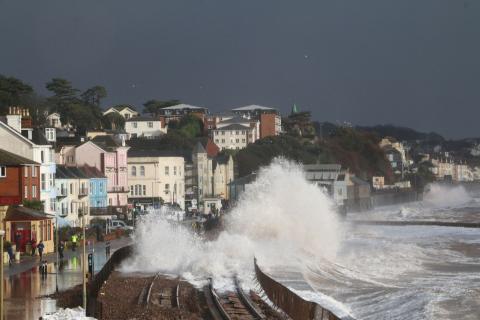
- Extreme water levels have become more frequent in the past 150 years, driven primarily by mean sea level rise.
- Mean sea-level rise and coastal squeeze (and changes in sediment supply) are contributing to a decline in the extent of saltmarshes, shingle beaches and sand dunes, which act as a natural buffer to flooding.
- Exposure to flooding is being exacerbated by population growth, changes in land use and increasing asset values in floodplains.
- Increased flood risk has largely been contained through improved flood defences, flood forecasting and emergency response. However, losses from major events that exceed design standards are growing in frequency.
- Preliminary results from ongoing research on compounded effects of flooding suggest that risk of flooding is significantly underestimated under today's climate and into the future.
High evidence, high consensus
Confidence remains ‘high’ here as there is a high level of consensus that: (1) extreme water levels are increasing in frequency due to rising mean sea levels; (2) that to date we managed this sufficiently to contain growth in flood risk; and (3) nonetheless losses in a major event – above defence design standards − are growing.
- Extreme water levels are certain to increase during the 21st Century and beyond, principally driven by accelerating mean sea-level rise.
- Continued loss of natural habitat buffers will dramatically increase defence capital and maintenance costs.
- By the 2080s, at current adaptation levels, estimated annual coastal flood damages is likely to increase 2 to 3-fold from £360m today, depending on temperature rise and population growth.
- 1,600 km of major roads, 650 km of railway, 92 railway stations and 55 historical landfill sites are likely to be at risk of coastal flooding or erosion by the end of the century.
- Socially vulnerable communities at the coast are disproportionally at risk, and this will increase more rapidly than for other communities, widening inequalities.
- For some coastal locations it will unfortunately no longer be technically or economically feasible to provide protection from flooding and coastal change. Initiatives such as the Coastal Transition Accelerator Programme are ongoing to explore, enable and accelerate the transition needed for coastal areas that cannot sustainably be defended in the long term.
Medium evidence, medium consensus
Confidence remains ‘medium’. While it is very likely extreme water levels and wave overtopping events will increase in frequency with mean sea-level rise, possible changes in the wave- and storm surge-climate and their spatially varying contribution to flood hazard remain uncertain and there is considerable uncertainty in how flood pathways and receptors will change in the future.
Top challenges:
1. Given that mean sea levels will continue to rise for many hundreds of years, we need to deliver practical portfolios of adaptation options that are technically feasible, can balance costs and benefits, can attract appropriate finance, are socially acceptable and can be prepared for and implemented before the need for adaptation becomes urgent.
2. As we aspire to increase the use of nature-based flood management solutions, we need new monitoring to assess the flood resilience offered by schemes and how they evolve over time, as well as better understand the limits of nature-based management in the context of their own vulnerability to climate change. In this regard, initiatives that build a better understanding of different types of natural coastal protection in a changing climate and with biodiversity loss are essential.
3. We need to identify the mechanisms, spatial extent and physical possible magnitude of low probability high impact extreme coastal flood events to inform emergency planning and calculate residual risk damages.
Top emerging issues:
1. Over the last decade there has been a move towards more-adaptive flood management and at local scale projects are showing homeowners and businesses how to make their homes more resilient to flooding.
2. It is unrealistic to promote a ‘hold the line’ policy for all the UK coastline based on a benefit-cost ratio and social justice considerations and realistic plans to adapt are needed now.
3. Coastal landfill sites need to be protected, but this may be at odds with Shoreline Management Plans that recommend ‘managed realignment’ or ‘no active intervention’.
Image credit: University of Plymouth